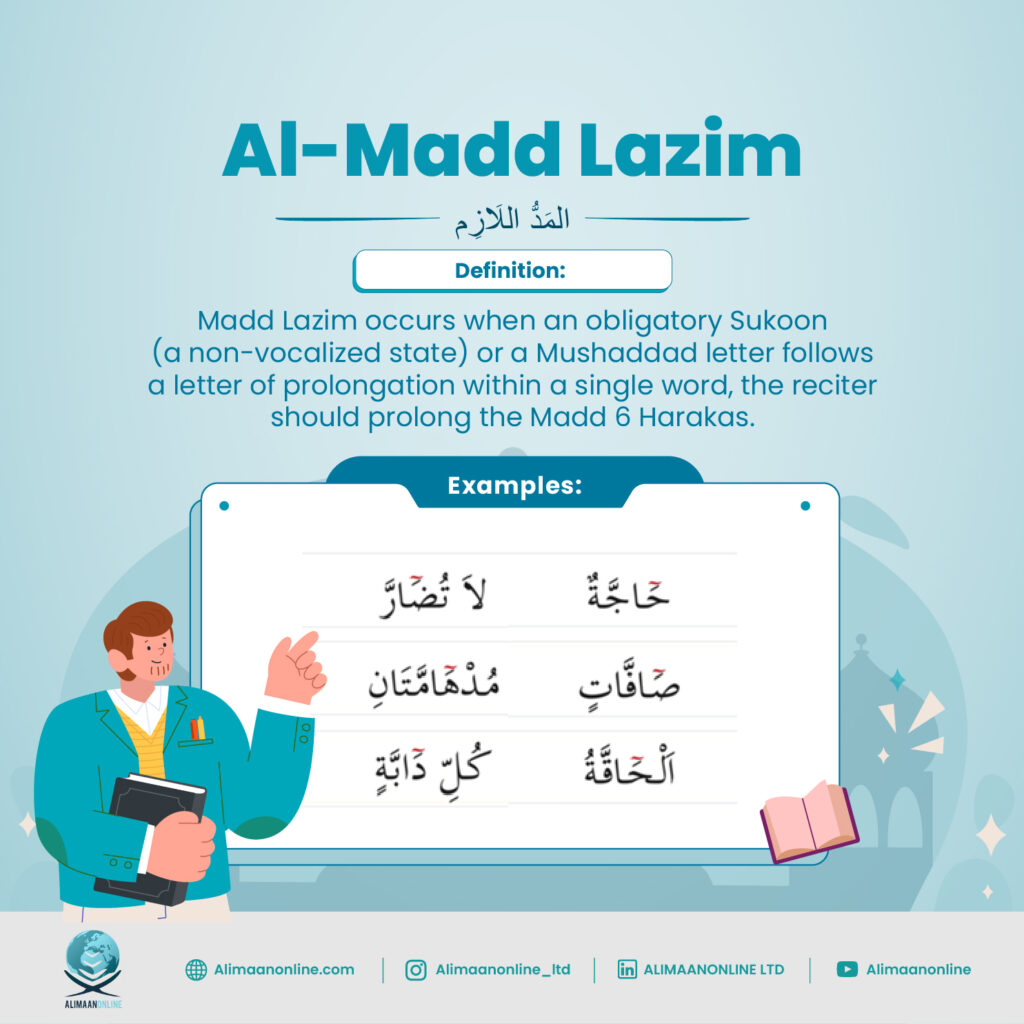In the realm of Tajweed, understanding Al-Madd Lazim is crucial for accurate Qur’anic recitation. This article will explore the definition of Madd Lazim, delve into its types, and provide insights into Madd Lazim Kalimi. Mastery of these concepts ensures that one’s recitation adheres to the precise rules of Tajweed, preserving the sacredness of the Qur’an’s pronunciation.
Definition of Madd Lazim
Al-Madd Lazim refers to a mandatory prolongation that occurs under specific conditions in Qur’anic recitation. The term “Lazim” translates to “necessary” or “obligatory,” indicating the non-negotiable nature of this rule. Madd Lazim occurs when a Madd letter is followed by an original Sukoon or Mushadad letter, requiring the reciter to elongate the vowel sound by six counts.
Types of Madd Lazim
Madd Lazim is considered the longest type of Madd. It can be classified into two main types: Kalimi (word-based) and Harfee (letter-based). These types further branch out into Muthaqal (heavy) and Mukhaffaf (light).
1) Al-Madd Lazim Kalimy المَدُّ اللَازِم الكَلِمَي
Madd Lazim Kalimi occurs within a single word when a vowel letter is followed by a letter with a permanent Sukoon. This type emphasizes the necessity of prolongation within the word itself.
1-Madd Lazim Kalimi Muthaqal
Madd Lazem Kalimee Muthaqqal occurs when a Madd letter is followed by a letter with Shaddah (doubling). In this case, the reader must prolong the Madd letter for a duration of 6 beats.
Examples of Madd Lazem Kalimee Muthaqqal:
- Arabic Word: ٱلْحَــــــآقَّةُ
Transliteration: al-ḥāqqah - Arabic Word: ٱلصَّآخَّةُ
Transliteration: aṣ-ṣākhah
2-Madd Lazim Kalimi Mukhaffaf
Madd Lazem Kalimee Mukhafaf occurs when a Madd letter is followed by a non-vowel letter within the same word. In this case, the reader must prolong the Madd letter for 6 beats.
Example of Madd Lazem Kalimee Mukhafaf:
Arabic Word: ءَآلْـَٰٔنَ
Transliteration: ‘āl-ā’nā
2) Al-Madd Lazim Harfy المَدُّ اللَازِم الحَرْفِي
The second branch of Madd Lazim is Madd Lazim Harfee, also recognized as letter-based necessary prolongation. This captivating exploration will delve into:
A. Madd Lazim Harfee Mukhaffaf
Madd Lazim Harfee Mukhaffaf is the embodiment of gentle letter-based necessary prolongation. It explains that each letter in this context is extended for a count of six unless a unique exception occurs. These letters have three distinct sounds, with the Harf Madd being the prominent one, while the final note remains silent without vocalization. The letter “qaaf” (ق) is an example, highlighting its poetic resonance. The progression of the sound starts with a strong “Q” sound, followed by the graceful Harf Madd “aa” represented by alif, and ending with a serene silent sound.
Examples of Madd Lazem Harfee Mukhafaf:
- Arabic Word: كٓهيعٓصٓ
Transliteration: kāf-hā-yā-ʿayn-ṣād - Arabic Word: الٓمٓ
Transliteration: alif-lām-mīm
B. Madd Lazim Harfee Muthaqal
Madd Lazim Harfee Muthaqal is a beautiful occurrence found in sacred scripture, where a letter at the beginning of a surah emits three melodious sounds and merges smoothly with the following letter. Surat Al-Baqarah’s opening contains the letters alif, laam, and meem with a focus on the graceful transition of the letter laam into a melodious Harf Madd “aa” sound. The “mm” sound of meem connects smoothly with the next verse.
The sequence of letters (طسٓمٓ) in the Qur’an involves a severed letter (س) with a madd sandwiched in between (م). When reciting, these letters are pronounced as “ta – seen – meem” and must be considered concerning the following letter for proper pronunciation. If a letter causes Idgham, it becomes Mushadad, meaning it is pronounced heavily.
Examples of Madd Lazem Harfee Muthaqqal:
- Arabic Word: الٓمٓصٓ
Transliteration: alif-lām-mīm-ṣād - Arabic Word: الٓمٓر
Transliteration: alif-lām-rā - Arabic Word: الٓمٓ
Transliteration: alif-lām-mīm
Three Exceptions of Madd Lazim
The rules of Madd Lazim govern the lengthening of specific letters, lending a distinct rhythm and melody to the sacred verses. Yet amid this melodic tapestry, exceptions emerge, each with its own unique charm and intrigue.
- The Ethereal Letter “Alif” (ا)
The first exception resides in the ethereal letter “alif” (ا), which refuses to conform to the prolonged fate of its counterparts. It boldly stands as “alif,” unyielding to elongation. Yet fear not, for its distinct pronunciation still carries a mystique of its own. - Defying Expectations: (hayy tuhr)
Next, we encounter a group of letters that chose a path less traveled. “Raa,” “haa,” “taa,” “yaa,” and “haa” (ح, ي, ط, هـ, ر) dare to merge their sounds with the realm of madd for merely two counts, defying expectations with grace. Remember them well, for they form a harmonious melody known as the phrase “hayy tuhr. - Distortion of Familiar Forms
The letters “raa,” “haa,” “taa,” “yaa,” and “haa” (ح, ي, ط, هـ, ر) shed their alphabetical pronunciations, unveiling a new identity. No longer shall “yaa’” (ياء) echo through the air; instead, only the graceful “yaa” (يا) shall emerge. This peculiarity extends its enchanting spell to all five letters. - Defying Expectations: (نقص عسلكم) Third, (ن، ق، ص،ع،س،ل،ك،م )dare to merge their sounds with the realm of madd for merely six counts.
- The Elusive Letter ‘Ayn’ (ع)
The letter ‘ayn’ (ع) is a subject of great intrigue among scholars. Its elongation knows no bounds, capable of extending its reign over time for 2, 4, or 6 counts. Though the preferred length is 4 counts, the wisdom behind this exception remains shrouded in mystery, a captivating enigma worth exploring.
Importance of Al-Madd Lazim
The correct application of Al-Madd Lazim is vital for preserving the intended rhythm and melody of Qur’anic recitation. This rule ensures that the reciter’s voice maintains the sacred and melodious nature of the Qur’an, which is not only a spiritual act but also a responsibility to uphold the divine words accurately.
Examples of Al-Madd Lazim in the Qur’an
To fully grasp the concept, it is helpful to examine examples from the Qur’an. The word “دابة” (Dabbah) in Surah An-Nur, Ayah 45, illustrates Madd Lazim Kalimi. The elongation occurs due to the Sukoon on the letter “ب”, requiring a six-count extension of the preceding vowel sound.
Application of Madd Lazim in Tajweed
Applying Madd Lazim correctly requires a deep understanding of its rules and consistent practice. Reciters should focus on identifying the conditions that trigger Madd Lazim and practice elongating the vowel sounds accordingly. Regular recitation under the guidance of a skilled teacher can significantly enhance one’s proficiency in applying this rule.
Conclusion
Al-Madd Lazim is an essential aspect of Tajweed that ensures the Qur’an is recited with precision and reverence. By understanding the definition of Madd Lazim, familiarizing oneself with its types, and practicing its application, reciters can honor the sacred text with accurate pronunciation. The journey to mastering Al-Madd Lazim is a step towards deepening one’s connection with the Qur’an and preserving its divine eloquence.

